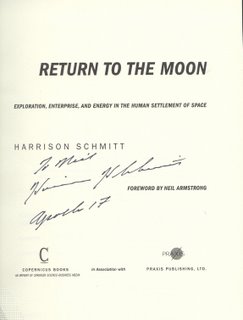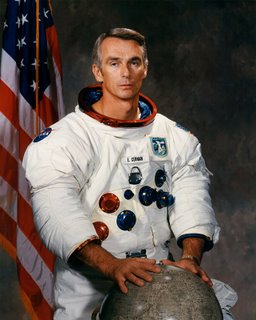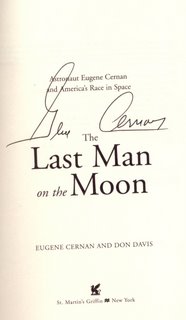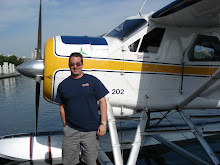Wednesday, July 26, 2006
Wednesday, July 12, 2006
Thomas P. Stafford 1930-


PERSONAL DATA: Born September 17, 1930, in Weatherford, Oklahoma. Married to the former Linda Ann Dishman of Chelsea, Oklahoma. They have two sons, Michael Thomas and Stanislav “Stas” Patten. First marriage was to the former Faye L. Shoemaker. They have two daughters, Dionne Kay and Karin Elaine as well as two grandsons, Thomas P. Stafford II and Andrew Alexi Harrison. Linda has two children from a previous marriage, Kassie Neering and Mark Hill, and four grandchildren: Sloane, Lee, Marcus and Tara. He enjoys hunting, scuba diving, fishing and deep sea fishing and swimming.
EDUCATION: Graduated from Weatherford High School, Weatherford, Oklahoma; received a Bachelor of Science degree from the United States Naval Academy in 1952. In addition, General Stafford is the recipient of several honorary degrees. These include a doctorate of laws from the University of Cordoba, Argentina, a doctorate of humane letters, University of Oklahoma and a masters of humane letters, Southwestern University, Weatherford, Oklahoma; a doctorate of science from Oklahoma City University; a doctorate of laws, Western State University, Los Angeles California; doctorate of communications, Emerson College, Boston, Massachusetts; a doctorate of aeronautical engineering, Embry-Riddle Aeronautical University, Daytona Beach, Florida, and a doctorate of humanities, Oklahoma Christian College, Edmond, Oklahoma.
ORGANIZATION: Fellow of the American Astronautical Society, American Institute of Aeronautics and Astronautics, the Society of Experimental Test Pilots, and a member of the Masonic Lodge.
SPECIAL HONORS: NASA Distinguished Service Medals (2), NASA Exceptional Service Medals (2), Air Force Distinguished Service Medal with 3 Oak Leaf Clusters, Air Force Distinguished Flying Cross with one Oak Leaf Cluster, Air Force Outstanding Unit Award with one Oak Leaf Cluster, Air Force Commendation Medal, Air Force Command Pilot Astronaut Wings. Other awards include the American Institute of Aeronautics and Astronautics (AIAA) Chanute Flight Award, the Veterans of Foreign Wars National Space Award, National Geographic Society's General Thomas D. White USAF Space Trophy, Federation Aeronautique Internationale Gold Space Medal. In 1966, he was co-recipient of the IAAA Award. He was honored with the Harmon International Aviation Trophy in 1966 and 1976. In 1969 he received the National Academy of Television Arts and Sciences Special Trustees Award and in 1978 the Los Angeles Area Chamber of Commerce Kitty Hawk Sands of Time Award; received the Society of Experimental Test Pilots James H. Doolittle Award for Management, September 1979, October 1979, received the NASA Medal for outstanding leadership, one of the Agency's highest awards. In 1993 General Stafford was the eighth recipient of the Congressional Space Medal of Honor. He was inducted into the Astronaut Hall of Fame and received the Rotary National Award for Space Achievement (RNASA). He served as the Chairman of the Operations Oversight Committee of the first Hubble Telescope Spacecraft Servicing and Repair Mission that corrected the design and manufacturing defect of the instrument. In 1994, NASA recognized his tremendous efforts and presented him with the NASA Public Service Award for the Hubble Telescope Service and Repair Mission. General Stafford was inducted into the Oklahoma Commerce and Industry Hall of Honor in October 1994, and to the National Aviation Hall of Fame and the Aerospace Walk of Honor in 1997.
EXPERIENCE: General Stafford graduated with honors in 1952 from the U.S. Naval Academy, Annapolis, Maryland, and was commissioned a second lieutenant in the United States Air Force. He received his pilot wings at Connally AFB, Waco, Texas, in September 1953. He completed advanced interceptor training and was assigned to the 54th Flight Interceptor Squadron, Ellsworth AFB, Rapid City, South Dakota. In December 1955 he was assigned to the 496th Fighter Interceptor Squadron, Hahn Air Base, Germany, where he performed the duties of pilot, flight leader, and flight test maintenance office, flying F-86Ds. He was an instructor in flight test training and specialized academic subjects-establishing basic textbooks and directing the writing of flight test manuals for use by the staff and students. He is co-author of the Pilot's Handbook for Performance Flight Testing and the Aerodynamics Handbook for Performance Flight Testing.
General Stafford was selected among the second group of astronauts in September 1962 by the National Aeronautics and Space Administration (NASA) to participate in Projects Gemini and Apollo. In December 1965, he piloted Gemini VI the first rendezvous in space, and helped develop techniques to prove the basic theory and practicality of space rendezvous. In June 1966 he commanded Gemini IX and performed a demonstration of an early rendezvous that would be used in Apollo, the first optical rendezvous, and a lunar orbit abort rendezvous. From August 1966 to October 1968 he headed the mission planning analysis and software development responsibilities for the astronaut group for Project Apollo.
General Stafford was the lead member of the group, which helped formulate the sequence of missions leading to the first lunar landing mission. He demonstrated and implemented the theory of a pilot manually flying the Saturn booster into orbit and the translunar injection maneuver.
General Stafford was commander of Apollo 10 in May 1969, first flight of the lunar module to the moon, performed the first rendezvous around the Moon, and performed the entire lunar landing mission except the actual landing.
He also made reconnaissance and tracking on future Apollo landing sites. General Stafford was cited in the Guinness Book of World Records for highest speed ever attained by man, that occurred during Apollo 10 reentry when the spacecraft attained 24,791 statute miles per hour.
He was assigned as head of the astronaut group in June 1969, responsible for the selection of flight crews for projects Apollo and Skylab. He reviewed and monitored flight crew training status reports, and was responsible for coordination, scheduling, and control of all activities involving NASA astronauts.
In June 1971, General Stafford was assigned as Deputy Director of Flight Crew Operations at the NASA Manned Space flight Center. He was responsible for assisting the director in planning and implementation of programs for the astronaut group, the Aircraft Operations, Flight Crew Integration, Flight Crew Procedures, and Crew Simulation and Training Divisions.
He logged his fourth space flight as Apollo commander of the Apollo-Soyuz Test Project (ASTP) mission, July 15-24, 1975, a joint space flight culminating in the historic first meeting in space between American Astronauts and Soviet Cosmonauts.
General Stafford was the first member of his Naval Academy Class of 1952 to pin on the first, second and third stars of a General Officer. He has flown six rendezvous in space; logged 507 hours and 43 minutes in space flight and wore the Air Force command Pilot Astronaut Wings. He has flown over 127 different types of aircraft and helicopters and four different types of spacecraft.
General Stafford assumed command of the Air Force Flight Test Center November 4, 1975. He was promoted to the grade of Major General August 9, 1975, with date of rank of June 1, 1973.
James A. Lovell 1928-


PERSONAL DATA: Born in Cleveland, Ohio, on March 25, 1928. Married to the former Marilyn Gerlach, of Milwaukee, Wisconsin. They have four children.
EDUCATION: University of Wisconsin; United States Naval Academy, bachelor of science, 1952; Test Pilot School, NATC, Patuxent River, Maryland, 1958; Aviation Safety School, University of Southern California, 1961; Advanced Management Program, Harvard Business School, 1971; honorary doctorates from Rockhurst college, Illinois Wesleyan University, Western Michigan University, Mary Hardin-Baylor College and Milwaukee School of Engineering.
SPECIAL HONORS: Eagle Scout; Sam Houston Area Council 1976 Distinguished Eagle Scout Award; Presidential Medal for Freedom, 1970; NASA Distinguished Service Medal; two Navy Distinguished Flying Crosses; 1967 FAI De Laval and Gold Space Medals (Athens, Greece); the American Academy of Achievement Golden Plate Award; City of New York Gold Medal in 1969; City of Houston Medal for Valor in 1969; the National Academy of Television Arts and Sciences special Trustees Award, 1969; the Institute of Navigation Award, 1969; the University of Wisconsin's Distinguished Alumni Service Award, 1970; co-recipient of the American Astronautical Society Flight Achievement Awards, 1966 and 1968; the Harmon International Trophy, 1966, 1967 and 1969; the Robert H. Goddard Memorial Trophy, 1969; the H. H. Arnold Trophy, 1969; General Thomas D. White USAF Space Trophy, 1969; Robert J. Collier Trophy, 1968; Henry G. Bennett Distinguished Service Award; and the AIAA Haley Astronautics Award, 1970.
AFFILIATIONS: Trustee of the National Space Institute; Fellow of the Society of Experimental Test Pilots; member Explorers Club; Fellow - American Astronautical Society; Captain Lovell is on the Board of Directors of the Federal Signal Corporation; Astronautics Corporation of America; Astronaut Memorial Foundation; Captain Lovell is also on the Sports Medicine Advisory Board at Rush Presbyterian - St. Lukes Medical Center. He is a regent emeritus for the Milwaukee School of Engineering; on the board of trustees of Lake Forest College; a trustee of the National Space Institute, the Association of Space Explorers; and the Chairman of the National Eagle Scouts Association.
EXPERIENCE: During his Naval career he has had numerous aviator assignments, including a 4-year tour as a test pilot at the Naval Air Test Center, Patuxent River, Maryland.While there he served as Program Manager for the F4H "Phantom" Fighter. A graduate of the Aviation Safety School of the University of Southern California, he also served as Safety Engineer with the Fighter Squadron 101 at the Naval Air Station, Oceana, Virginia.He has logged more than 7,000 hours flying time--more than 3,500 hours in jet aircraft.
NASA EXPERIENCE: Captain Lovell was selected as an Astronaut by NASA in September 1962. He has since served as backup pilot for the Gemini 4 flight and backup Commander for the Gemini 9 flight, as well as backup Commander to Neil Armstrong for the Apollo 11 lunar landing mission.On December 4, 1965, he and Frank Borman were launched into space on the history-making Gemini 7 mission. The flight lasted 330 hours and 35 minutes and included the first rendezvous of two manned maneuverable spacecraft.The Gemini 12 mission, commanded by Lovell with Pilot Edwin Aldrin, began on November 11, 1966. This 4-day, 59-revolution flight brought the Gemini program to a successful close. Lovell served as Command Module Pilot and Navigator on the epic six-day journey of Apollo 8 - man's maiden voyage to the moon - December 21-27, 1968. Apollo 8 was the first manned spacecraft to be lifted into near-earth orbit by a 7-1/2 million pound thrust Saturn V launch vehicle; and Lovell and fellow crewmen, Frank Borman and William A. Anders, became the first humans to leave the Earth's gravitational influence.He completed his fourth mission as Spacecraft Commander of the Apollo 13 flight, April 11-17, 1970, and became the first man to journey twice to the moon. Apollo 13 was programmed for ten days. However, the original flight plan was modified en route to the moon due to a failure of the Service Module cryogenic oxygen system. Lovell and fellow crewmen, John L. Swigert and Fred W. Haise, working closely with Houston ground controllers, converted their lunar module "Aquarius" into an effective lifeboat. Their emergency activation and operation of lunar module systems conserved both electrical power and water in sufficient supply to assure their safety and survival while in space and for the return to earth.Captain Lovell held the record for time in space with a total of 715 hours and 5 minutes until surpassed by the Skylab flights.On March 1, 1973, Captain Lovell retired from the Navy and from the Space Program
Saturday, July 01, 2006
James B. Irwin 1930-1991


PERSONAL DATA: Born March 17, 1930, in Pittsburgh, Pennsylvania. Died August 8, 1991 of a heart attack. He is survived by his wife Mary Ellen and their five children.
EDUCATION: Graduated from East High School, Salt Lake City, Utah. He received a Bachelor of Science degree in Naval Science from the United States Naval Academy in 1951 and Master of Science degrees in Aeronautical Engineering and Instrumentation Engineering from the University of Michigan in 1957. Awarded an Honorary Doctorate of Astronautical Science from the University of Michigan in 1971, an Honorary Doctorate of Science from William Jewell College in 1971, and an Honorary Doctorate from Samford University in Birmingham, Alabama, in 1972.
ORGANIZATIONS: Member of the Air Force Association and the Society of Experimental Test Pilots.
SPECIAL HONORS: Recipient of the NASA Distinguished Service Medal, the Air Force Distinguished Service Medal and Command Pilot Astronaut Wings, two Air Force Commendation Medals for service with the Air Force Systems Command and the Air Defense Command, and an Outstanding Unit Citation while a member of the 4750th Training Wing; also awarded the City of New York Gold Medal (1971), the United Nations Peace Medal in 1971, the City of Chicago Gold Medal (1971), the Air Force Association's David C. Schilling Trophy (1971), the 1971 Kitty Hawk Memorial Award, the AIAA Haley Astronautics Award for 1972, the Arnold Air Society's 1972 John F. Kennedy Trophy, the Robert J. Collier Trophy for 1971, Belgium's Order of Leopold (1971), and the New York Police Department St. George Association's Golden Rule Award in 1972, the christian Service Award, and the Milan Hulbert Trophy of SWAP International (1973).
EXPERIENCE: Irwin, an Air Force Colonel, was commissioned in the Air Force upon graduation from the Naval Academy in 1951. He received his flight training at Hondo Air Base and Reese Air Force Base, Texas.Prior to reporting for duty at the Manned Spacecraft Center, he was assigned as Chief of the Advanced Requirements Branch at Headquarters Air Defense Command. He was graduated from the Air Force Aerospace Research Pilot School in 1963 and from the Air Force Experimental Test Pilot School in 1961.He also served with the F-12 Test Force at Edwards Air Force Base, California, and with the AIM 47 Project Office at Wright-Patterson Air Force Base, Ohio.During his military career, he accumulated more than 7,015 hours flying time, 5,300 hours in jet aircraft.
NASA EXPERIENCE: Colonel Irwin was one of the 19 astronauts selected by NASA in April 1966. He was crew commander of lunar module (LTA-8)-this vehicle finished the first series of thermal vacuum tests on June 1, 1968. He also served as a member of the astronaut support crew for Apollo 10 and as backup lunar module pilot for the Apollo 12 flight.Irwin served as lunar module pilot for Apollo, July 26 to August 7, 1971. His companions on the flight were David R. Scott, spacecraft commander and Alfred M. Worden, command module pilot. Apollo 15 was the fourth manned lunar landing mission and the first to visit and explore the moon's Hadley Rille and Apennine Mountains which are located on the southeast edge of the Mare Imbrium (Sea of Rains). The lunar module, "Falcon", remained on the lunar surface for 66 hours, 54 minutes-setting a new record for lunar surface stay time-and Scott and Irwin logged 18 hours and 35 minutes each in extravehicular activities conducted during three separate excursions onto the lunar surface. Using "Rover-l" to transport themselves and their equipment along portions of Hadley Rille and the Apinnine Mountains, Scott and Irwin performed a selenological inspection and survey of the area and collected approximately 180 pounds of lunar surface materials. They deployed an ALSEP package which involved the emplacement and activation of surface experiments, and their lunar surface activities were televised in color using a TV camera which was operated remotely by ground controllers stationed in the mission control center located at Houston, Texas. Other Apollo 15 achievements included: largest payloads ever placed in earth and lunar orbits; first scientific instrument module bay flown and operated on an Apollo spacecraft; longest distance traversed on lunar surface; first use of a lunar surface navigation device, mounted on Rover 1; first subsatellite launched in lunar orbit; and first extravehicular activity (EVA) from a command module during transearth coast. The latter feat was accomplished by Worden during three excursions to "Endeavour's" SIM bay where he retrieved film cassettes from the panoramic and mapping cameras and reported his personal observations of the general condition of equipment housed there.Apollo 15 concluded with a Pacific splashdown and subsequent recovery by the USS OKINAWA.In completing his first flight, Irwin logged 295 hours and 11 minutes in space-19 hours and 46 minutes of which were in EVA.







